Difference between revisions of "Ermanox"
m (added Category:Zeiss Ikon using HotCat) |
m (removed Category:4.5x6 plate strut folding using HotCat) |
||
| Line 362: | Line 362: | ||
[[Category: German 4.5x6 plate]] | [[Category: German 4.5x6 plate]] | ||
[[Category: German 4.5x6 viewfinder]] | [[Category: German 4.5x6 viewfinder]] | ||
| − | |||
[[Category: Ernemann]] | [[Category: Ernemann]] | ||
[[Category: E]] | [[Category: E]] | ||
Revision as of 14:11, 18 February 2024

|
| image by Mario Groleau (Image rights) |
| Catalogue numbers of various models POA: Price on Application | |||
| Ernemann 1924 |
Zeiss Ikon 1927 |
Zeiss Ikon 1930 | |
| 4.5x6cm, f/2 | 254 | 479, X | n/a |
| 4.5x6cm f/1.8 | n/a | 479, Y | 858 |
| 6.5x9cm | n/a | 480 | 858/3 |
| 9x12cm | n/a | 481 | n/a |
| 10x15cm | n/a | No code, POA | n/a |
| 13x18cm | n/a | No code, POA | n/a |

|
| Advertisement by Central Camera Co., 1926 scanned by Mario Groleau (Image rights) |

|
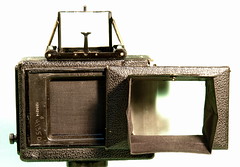
|

|
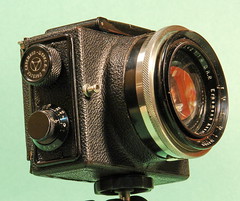
|

|
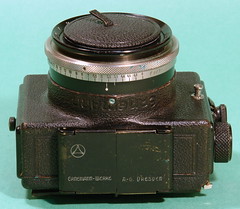
|
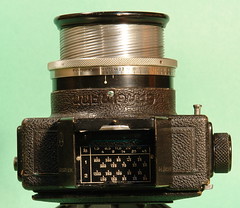
|

|
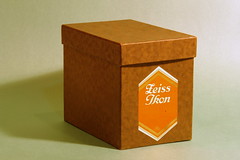
|

|
| images by Mario Groleau (Image rights) | |
The Ermanox is a camera for 4.5x6cm plates made by Ernemann in Dresden from 1924, and also seen in 6.5x9cm and 9x12cm sizes (see the advertisement below right, and examples cited), though the small model is the most commonly seen. Zeiss Ikon's 1927 catalogue (linked below) even offers the camera in 10x15cm and 13x18cm sizes (as a special order, 'price on request'); no example of either size has been seen, though a 24cm f/1.8 Ernostar suitable for the 13x18cm camera was sold at Westlicht (see the links below). The 1931 catalogue (also linked below) only offers the 4.5x6cm and 6.5x9cm cameras. Some (not much) advertising for the camera also used the name Er-Nox, as in the text of the 1926 advertisement below right. When introduced, the camera was supplied with a 10cm f/2 Ernostar; later an 8.5cm f/1.8 Ernostar was offered (12.5cm and 16.5cm f/1.8 for the two larger cameras). The 1927 Zeiss Ikon catalogue offers both the f/2 and f/1.8 lenses, but actual examples seen suggest that customers chose the fast lens once it was available. The 1930 catalogue only offers the f/1.8 lens. Cameras with the short, fast lens have a significantly shorter lens tube, and are lighter: the camera body is mostly aluminium (covered with black leather), but the lens-mount is brass and makes up a lot of the weight. The 4.5x6cm model of the camera has a rigid body; the larger models are strut-folding. All have the folding Newton viewfinder as shown here. A ground-glass focusing screen can also be used, and one was supplied with the camera. The camera has a focal-plane shutter, with speeds 1/20 - 1/1000 second, plus 'B' and 'T' (slowest speed 1/15 second in the 9x12cm camera).
The unusually large aperture made available light photography a real possibility. It was this feature that made the camera famous, especially in the hands of Dr. Erich Salomon (1886-1944), who used it to make candids. The maker's instructions stress the care needed when focusing at such wide aperture, and discourage the use of film-packs, which may not lie as flat as plates.
In the earliest example cited below (with lens serial no. 148233), the focus scale is marked on the painted lens tube, with the index mark on the plated focusing ring. In all other examples the scale is on the ring, and the pointer on the tube. In all examples there is a single indent in the ring and a toothed spring on the bottom of the tube which mates with it when the lens is at infinity focus, giving a 'click-stop'. Later lenses (from serial number 150503 in the examples cited here) have a more precise focus scale than previously, with more marked distances (and the closest distances marked to two places of decimals in some cases).
A strut-folding 9x12cm Ermanox made in tropical materials (uncovered mahogany with brass fittings and tan leather bellows) has been seen at Westlicht; the notes suggest this camera may be unique (i.e. made in tropical finish to a special order: other non-tropical 9x12cm examples exist). It has a 16.5cm f/1.8 Ernostar in black finish.
There is also an SLR model, the Ermanox Reflex, which has a focusing screen on the top, with a folding leather hood, and a rear screen. This has a 10.5cm f/1.8 Ernostar: the 1927 Zeiss Ikon catalogue also offers the camera with either this lens or a 9cm f/2.7 Ernostar; no example has been seen with the slower lens. Later cameras have lenses made by Carl Zeiss (marked as such on the name-ring), with a focusing knob on the left side of the barrel instead of a ring.
Both the viewfinder and reflex cameras were copied by other makers, but while surviving examples of the Ermanox cameras are rare enough, all the copies are vanishingly so. Viewfinder copies include the Lorenz Nacht Kamera with an f/2 Plasmat, the Thornton Pickard Ruby Speed Camera with an f/2 Cooke Anastigmat, and a 'night camera' by Sommer with an f/1.5 Plasmat. Reflex copies include the Mentor Wonder Reflex for 6.5x9cm plates, with an f/1.9 Rietzschel/Agfa Prolinear, and the Ihagee Nachtreflex, with an f/1.5 Plasmat.
Known examples, at Westlicht auctions, etc.
4.x6cm viewfinder Ermanox
| Body Serial no. if known |
Lens Serial no. (link to source) |
Focal length & f-no. |
Comments | Westlicht/Leitz Auction no. |
| 1139240 | 148233 | 10cm f/2 | Speed table in French | 37 |
| 1184920 | 150266 | 10cm f/2 | 31 | |
| 1235814 | 150287 | 10cm f/2 | In the stock of dealer Coeln Cameras | n/a |
| 1184987 | 150289 | 10cm f/2 | 7 | |
| 150297 | 10cm f/2 | 42 | ||
| 1185098 | 150503 | 10cm f/2 | First camera seen with more precise focus scale | 16 |
| 1185290 | 150548 | 10cm f/2 | 12 | |
| 1039149 | 150618 | 10cm f/2 | 32 | |
| 1185381 | 150666 | 10cm f/2 | 11 | |
| 1185427 | 150802 | 10cm f/2 | 20 | |
| 1235777 | 150967 | 10cm f/2 | 18 | |
| 1185547 | 151067 | 10cm f/2 | 8 | |
| 1038999 | 166029 | 10cm f/2 | w/ Rollex rollfilm back (for 127) | 19 |
| 1253577 | 167170 | 8.5cm f/1.8 | With its box | 16 |
| 1254025 | 167265 | 8.5cm f/1.8 | Focus in feet. At Early Photography | n/a |
| 1253880 | 167428 | 8.5cm f/1.8 | Focus in feet. Round Zeiss Ikon badge by viewfinder. Flint Auctions, 2020. With sales receipt dated April 1934. |
n/a |
| 1253836 | 167552 | 8.5cm f/1.8 | Impressed 'Ernemann', but with Zeiss Ikon badge. | 8 |
| 1253718 | 167569 | 8.5cm f/1.8 | Speed table in English, focusing in feet; Zeiss Ikon badge | 28 |
| 1254214 | 1342114 | 8.5cm f/1.8 | The camera pictured here | n/a |
| 1254444 | 167639 | 8.5cm f/1.8 | 18 | |
| 1109182 | 8.5cm f/1.8 | Speeds in English, focus in feet; Zeiss Ikon badge. Lens serial seems wrong; can't be read in auction photos |
34 |
4.5x6cm Ermanox Reflex
| Body Serial no. if known |
Lens Serial no. (link to source) |
Focal length & f-no. |
Comments | Westlicht/Leitz Auction no. |
| 1297263 | 179626 | 10.5cm f/1.8 | 18 | |
| 1297308 | 179705 | 10.5cm f/1.8 | 13 | |
| 1297315 | 205312 | 10.5cm f/1.8 | Speed table in English | 17 |
| M.99906 | 224877 | 10.5cm f/1.8 | With 15cm f/2.7 Ernostar in same lot, at Christie's, 2002. Likely lens has been exchanged by user (see position of focus knob). |
n/a |
| M.99925 | 917001 | 10.5cm f/1.8 | First Ernostar lens made by Carl Zeiss Jena for Ernemann | 27 |
| M.00064 | 917021 | 10.5cm f/1.8 | CZJ Ernostar | 6 |
| M.99928 | 917072 | 10.5cm f/1.8 | CZJ Ernostar | 28 |
| 917099 | 10.5cm f/1.8 | CZJ Ernostar | 20 |
6.5x9cm strut-folding Ermanox
| Body Serial no. if known |
Lens Serial no. (link to source) |
Focal length & f-no. |
Comments | Westlicht/Leitz Auction no. |
| 1168023 | 192063 | 12.5cm f/1.8 | 13 | |
| 1322310 | 192098 | 12.5cm f/1.8 | 6 |
9x12cm strut-folding Ermanox
| Body Serial no. if known |
Lens Serial no. (link to source) |
Focal length & f-no. |
Comments | Westlicht/Leitz Auction no. |
| 1051818 | 166982 | 16.5cm f/1.8 | 34 | |
| 1053977 | 166993 | 16.5cm f/1.8 | Tropical, and with speed table in French | 24 |
| 1051646 | 167048 | 16.5cm f/1.8 | At the George Eastman Museum. | n/a |
Links
- 24cm f/1.8 Ernostar serial no. 15970, possibly the lens from a 13x18cm Ermanox, sold at the 31st Westlicht Auction.
- Catalogues, reproduced at Pacific Rim Camera:
- 1924 Ernemann catalogue, with the 10cm f/2 Ernostar on p12 and the 4.5x6cm Ermanox on p45.
- 1927 Zeiss Ikon catalogue (260-MB pdf, German, but with Czech prices), with the Ermanox and Ermanox Reflex on p37.
- 1930 Zeiss Ikon catalogue (253-MB pdf, English), with the Ermanox and Ermanox Reflex on pp47-48. The entry seems to damn the Ernostar with faint praise: The ERNOSTAR F 1.8 is an anastigmat of the highest class and the definition is so good that enlargements up to 5½"x3½" can be made with the greatest ease.
- Directions for Use of the Ermanox 4.5x6 in English and French (pdf, just four pages in each language) at Internet Archive.
- Dr. Erich Salomon, a photographer using the Ermanox, at German Wikipedia. Article in German.
- Lichtstärke Ermanox-Aufnahmen 1928 bis 1932, Erich Salomon, published by Franz Greno, 1988. ISBN 3891908717. Listed as Public Domain at the Internet Archive. Mostly interior photographs of public meetings, dinners, etc. - quite commonplace photographs by modern standards.
- Roll-film back for 4.5x6cm Ermanox badged for 'Salomon, Erfurt', with shoe-mounting brilliant finder, and with unused roll of film, in a tropical container; at the seventh Westlicht Auction.